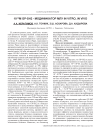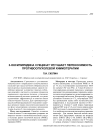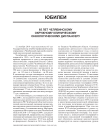Статьи журнала - Сибирский онкологический журнал
Все статьи: 3705
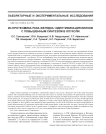
2D-протеомика рака желудка: идентификация белков с повышенным синтезом в опухоли
Статья научная
Проведен сравнительный протеомный анализ опухолевой и нормальной ткани желудка для идентификации белков, синтез которых значительно повышен в опухоли по сравнению с нормой. Использовались парные образцы опухолевой и нормальной ткани от пациентов с диагнозом рак желудка, полученные при проведении оперативного вмешательства. Для увеличения разрешающей способности 2D-гель электрофореза была использована предварительная экстракция раство- римой фракции белков для удаления мажорных структурных белков. В ходе сравнительного анализа белковых профилей опухолевой и нормальной тканей 4 пациентов с помощью MALDI-TOF масс-спектрометрии выявлено увеличение синтеза 6 белков: тропомиозина-3, тимозина бета-10, циклофилина А, катепсина Д, белка hCG1816442 и белка S100-A9. Повы- шенный уровень синтеза большинства белков подтверждается литературными данными, однако стабильное повышение уровня синтеза белка hCG1816442 в опухоли желудка обнаружено нами впервые. Для циклофилина A показан высокий уровень экспрессии только в опухолевой ткани желудка, что делает перспективными дальнейшие исследования для оценки его диагностической значимости.
Бесплатно
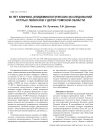
50 лет клинико-эпидемиологических исследований острых лейкозов у детей Томской области
Статья научная
Представлены итоги 50-летних (1958-2007 гг.) клинико-эпидемиологических исследований по проблеме острых лейкозов у детей Томской области. Показано, что первичная заболеваемость острыми лейкозами детей на протяжении указанного периода сохраняется в пределах средних величин. Преобладающей формой является острый лимфобластный лейкоз. Уста- новлено статистически значимое преобладание пациентов с дигестивным типом телосложения.
Бесплатно
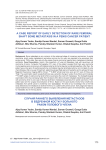
A case report of early detection of rare femoral shaft bone metastasis in a penis cancer patient
Статья научная
Background. Bone metastasis is very common in the advanced stage of numerous carcinomas. In penile carcinoma, lymph nodes metastasis is somehow common but it is very rare reported to be secondary from penile cancer. Till the date, there are only few cases of penis carcinoma reported bone metastasis in literature worldwide. Case Presentation. Herein, We presented a 51-year-old Nepalese male with squamous cell carcinoma of penis. Computed Tomography (CT) scan of the patient revealed that there was carcinoma involving glans penis and precure with bilateral external & internal inguinal Lymphadenopathies. After then, the patient was under gone for partial penectomy and bilateral inguinal lymphadenectomy and complete 6-cycle chemotherapy. After one year of treatment, patient developed thigh pain and headache and he advised to have Magnetic Resonance Imaging (MRI) of brain, 99mTc-MDP whole body bone scan and CT scan of Pelvis and Thigh. The examination report reveals that there was a sclerotic change in vertex of skull bone and moderate 99mTc-MDP uptake in right proximal shaft of femur just below the neck D/D metastasis. The histopathological examination of the true cut biopsy taken from the lesion of the femur showed metastatic keratinizing squamous cell carcinoma which is rare case of femoral shaft bone metastasis secondary from penile carcinoma. Then patient was sent for surgical reconstruction of femur. Based on the case studies review femur shaft bone metastasis from penile cancer is extremely rare.
Бесплатно
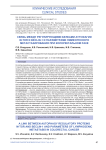
Статья научная
Currently the impact of autophagy on carcinogenesis remains understudied. On the one hand, autophagy acts as a tumor suppressor, as it activates degradation of oncoproteins, toxic proteins, and damaged cell organelles, that may be aggressive and lead to DNA damage. On the other hand, autophagy may promote tumor cell survival under hypoxia and in the presence of reactive oxygen species, which occurs primarily due to blocking of apoptosis mechanisms, raising the chances for maintaining tumor clone dynamics. Autophagy regulation is a complicated and multi-stage process. The main regulator here is a signaling pathway that activates serine/threonine protein kinase m-TOR (the mammalian target of rapamycin). Data on the impact of autophagic proteins ATg5, LC3A, LC3b, and beclin-1 on malignant cell survival as well as on tumor growth and progression have been reported in literature. However, studies aimed at seeking possible relationships between autophagy and pathogenetic mechanisms of carcinogenesis are of great interest. the aim of the study is to investigate a relationship between the expression parameters of autophagy regulatory proteins m-TOR and beclin-1 and the features of lymphogenic metastasis in colorectal cancer. materials and methods. The study included 105 patients with T1-4N0-3M0 colorectal cancer treated in the Thoracic and Abdominal Department of Cancer Research Institute of Tomsk Research Medical Center from 2012 to 2015. The average age of patients was 59.7±4.3 years. Morphological verification of the diagnosis was performed on the biopsy samples of primary tumor tissue. Staging of colorectal cancer was determined according to the TNM classification of malignant tumors (2002). results. Analysis of the frequency of lymphogenic metastasis depending on the presence or absence of m-Tor and beclin-1 expression in tumor cell cytoplasm revealed a statistically significant link between these variables. Conclusion. The obtained findings clearly exhibit that deceleration or loss of autophagic activity in the tumor is accompanied by implementation of lymphogenic dissemination, which is a predictor of an unfavorable outcome of the disease.
Бесплатно
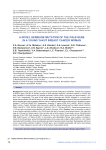
A novel germline mutation of the PALB gene in a young Yakut breast cancer woman
Статья научная
Background. Breast cancer (Bc) is the most common female malignancy worldwide. partner and localizer of BRCA2 gene ( PALB2 ) is directly involved in dNa damage response. germline mutation in PALB2 has been identified in breast cancer and familial pancreatic cancer cases, accounting for approximately 1-2% and 3-4%, respectively. the goal of this report was to describe new PALB2 mutation in a young Yakut breast cancer patient with family history of cancer. material and methods. genomic dNa were isolated from blood samples and used to prepare libraries using a capture-based target enrichment kit, Hereditary cancer solution™ (sopHia geNetics, switzerland), covering 27 genes ( ATM, APC, BARD1, BRCA1, BRCA2, BRIP1, CDH1, CHEK2, EPCAM, FAM175A, MLH1, MRE11A, MSH2, MSH6, MUTYH, NBN, PALB2, PIK3CA, PMS2, PMS2CL, PTEN, RAD50, RAD51C, RAD51D, STK11, TP53 and XRCC2 ). paired-end sequencing (2 × 150 bp) was conducted using Nextseq 500 system (illumina, usa). Results. Here we describe a case of a never-before-reported mutation in the PALB gene that led to the early onset breast cancer. We report the case of a 39-year-old breast cancer Yakut woman with a family history of pancreatic cancer. Bioinformatics analysis of the Ngs data revealed the presence of the new PALB2 gene germinal frameshift deletion (Nm_024675:exon1:c.47dela:p.K16fs). in accordance with dbpubmed clinVar, new mutation is located in codon of the PALB2 gene, where the likely pathogenic donor splice site mutation (Nm_024675.3:c.48+1delg) associated with hereditary cancer-predisposing syndrome has been earlier described. Conclusion. We found a new never-before-reported mutation in palB2 gene, which probably associated with early onset breast cancer in Yakut indigenous women with a family history of pancreatic cancer.
Бесплатно
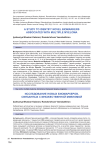
A study to identify novel biomarkers associated with multiple myeloma
Статья научная
Background. Multiple Myeloma (MM) is a plasma cell cancer that affects white blood cells. Plasma cells from the bone marrow grow abnormally, as a consequence of which patients have high amounts of monoclonal immunoglobulin in their blood and urine, poor renal function, and recurring infections due to this condition. Osteolytic bone lesions and immunodeficiency also impact multiple myeloma patients’ longevity and quality of life. The disease accounts for 13 % of all hematological malignancies worldwide, making it the second most common blood cancer. Material and Methods. The studies investigating MM biomarkers from 2000 to 2021 are collected from various databases. “Multiple myeloma”, “biomarkers”, “genetic markers”, “prognostic markers”, “Epidemiology of multiple myeloma”, and “risk factors for multiple myeloma” are the key phrases utilized to gather the articles.
Бесплатно
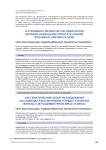
A systematic review on the association between ovarian and prostate cancer with BRCA1 and BRCA2 gene
Статья научная
Background. BRCA1 and BRCA2 were discussed as the basis of inherited adenocarcinoma and breast and ovarian malignancy. Ovarian cancer is uncommon in women below 40 years of age, and prostate cancer mainly occurs in older men cause 90 % in those above sixty-five. Objective. The main objective of this paper is to investigate the relationship between ovarian and prostate cancer with the BRCA1 and BRCA2 genes. Material and Methods. The ovarian and prostate cancer mechanism is discussed in detail, and their preventive measures with screening techniques are also demonstrated. This systematic review collected the related articles from online databases using the key terms ovarian cancer, prostate cancer, BRCA genes, mutation, polymorphism, carcinoma, sarcoma, and genetic association. Results. Based on the obtained information, it is found that the BRCA genes are highly associated with prostate cancer in men, and in women, it is significantly linked with breast cancer than ovarian cancer. Conclusion. Therefore, early diagnosis and genetic testing for BRCA1&BRCA2 genes in both men and women are necessary. in some cases, these genes might even cause different types of cancer like pancreatic cancers. identifying individuals with tumour-HRD through mutations in the homologous repair pathway and determining this gene expression is essential to improve treatment techniques developed during the previous decade and rapidly make their way into clinical trials practice. However, the safe introduction of these medicines into everyday practice will require a thorough understanding of treatment targets and associated adverse effects.
Бесплатно
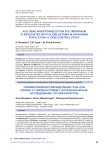
Статья научная
Background. The insertion/deletion (I/D) polymorphism of the angiotensin-converting enzyme (ACE) gene has recently been reported to be associated with the pathogenesis and development of human cancers. This study aimed to assess the potential association between ACE (I/D) polymorphism and glioblastoma in an Iranian population. Material and Methods. This case-control study was conducted on 80 patients with glioblastoma and 80 healthy blood donors as controls. Gap-polymerase chain reaction (Gap-PCR) was used to determine the ACE (I/D) genotypes. PCR products were separated and measured by electrophoresis on a 2 % agarose gel. Results. Analysis of demographic data showed a significant difference in the family history of cancer between the case and control groups (p=0.03). The distribution of ACE gene variants including II, ID, and DD genotypes was also calculated, and significant differences were seen in the DD genotype (p=0.03) and D allele (p=0.04) between the glioblastoma cases and controls. Conclusion. ACE gene polymorphism was associated with glioblastoma in the study population. Further studies are needed to approve this finding.
Бесплатно

Abscopal effect of radiotherapy and hyperthermia: role of exosomes
Статья обзорная
The review presents data on the role of ionizing radiation/hyperthermia as modulating factors in exosome secretion/composition. Tumor-derived exosomes are important participants in the formation of the tumor microenvironment. They modulate the inflammatory response in the tumor, influence the capability of fibroblasts and mesenchymal cells to differentiate into myofibroblasts, trigger the angiogenic process, promote epithelial to mesenchymal transformation of tumor cells and form the pre-metastatic nisches. The review describes the mechanisms of behavior of the recipient tumor cells receiving exosomes from irradiated cells, including activation of Akt signaling, stabilization of MMP9/MMP2, and enhancement of exosome-mediated motility. In vitro models demonstrate the efficacy of exosomes from mesenchymal stem cells (MSC) to modulate both direct and abscopal effects of radiation therapy/hyperthermia. Exosomes derived from MSC are the most attractive carriers for the delivery of proteins, miRNAs, drugs, and metals to the recipient tumor cells. MSC-derived exosomes potentiate the efficacy of both radiotherapy and hyperthermia in vitro studies. However, some important aspects regarding a) the most effective options for administering MSC/MSC exosomes to modulate radiotherapy/hyperthermia; b) radiation dose; c) options of hyperthermia; d) detailed mechanisms of the effect of irradiated MSC-derived exosomes on the tumor microenvironment and cancer cells, still remain poorly understood.
Бесплатно

Статья научная
Background. scc of the gallbladder is characterized by more rapid and invasive growth with infiltration of the adjacent organs and less spread to the lymph nodes compared to adenocarcinoma of the gallbladder. it is a rare neoplasm that accounts for 1.4-12.7 % of gallbladder tumors. scc of the gallbladder has a poor prognosis. symptoms usually appear later when the disease has progressed and the malignancy has reached advanced stages. therefore, usually, the patients expire soon following the diagnosis. the etiology of the scc of the gallbladder is complex and is mostly associated with gallstones. Case description. We report a case of a 56-year-old man that had been suffering from colicky abdominal pain in the right upper quadrant for about two weeks before his admission. He did not have nausea, vomiting, shortness of breath, fever, lack of appetite, or weight loss. after evaluation, a diagnosis of acute cholecystitis was established and antibiotic therapy was initiated. However, he did not respond to medical therapy and underwent surgery. a tumor mass was detected during surgery. therefore, cholecystectomy and extended right hepatectomy were performed. the pathological evaluation of the biopsy specimen revealed squamous cell carcinoma. consequently, he underwent radiotherapy and chemotherapy and was followed up for two years. He acquired complete tumor remission. Conclusion. the present case highlights the requirement of considering further investigation on the histogenesis of scc of the gallbladder.
Бесплатно
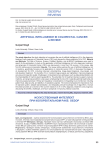
Artificial intelligence in colorectal cancer: a review
Статья научная
The study objective: the study objective is to examine the use of artificial intelligence (AI) in the diagnosis, treatment, and prognosis of Colorectal Cancer (CRC) and discuss the future potential of AI in CRC. Material and Methods. The Web of Science, Scopus, PubMed, Medline, and eLIBRARY databases were used to search for the publications. A study on the application of Artificial Intelligence (AI) to the diagnosis, treatment, and prognosis of Colorectal Cancer (CRC) was discovered in more than 100 sources. In the review, data from 83 articles were incorporated. Results. The review article explores the use of artificial intelligence (AI) in medicine, specifically focusing on its applications in colorectal cancer (CRC). It discusses the stages of AI development for CRC, including molecular understanding, image-based diagnosis, drug design, and individualized treatment. The benefits of AI in medical image analysis are highlighted, improving diagnosis accuracy and inspection quality. Challenges in AI development are addressed, such as data standardization and the interpretability of machine learning algorithms. The potential of AI in treatment decision support, precision medicine, and prognosis prediction is discussed, emphasizing the role of AI in selecting optimal treatments and improving surgical precision. Ethical and regulatory considerations in integrating AI are mentioned, including patient trust, data security, and liability in AI-assisted surgeries. The review emphasizes the importance of an AI standard system, dataset standardization, and integrating clinical knowledge into AI algorithms. Overall, the article provides an overview of the current research on AI in CRC diagnosis, treatment, and prognosis, discussing its benefits, challenges, and future prospects in improving medical outcomes.
Бесплатно
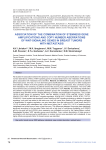
Статья научная
We studied the association between the presence of 2 or more stemness gene amplifications as well as copy number aberrations (CNAs) of WNT signaling genes in residual breast tumor and metastasis. WNT pathway genes associated with metastasis were identified. Material and Methods. The study included 30 patients with breast cancer, who had 2 or more stemness gene amplifications in the residual tumor after neoadjuvant chemotherapy. Fifteen of the thirty patients developed hematogenous metastases; they constituted a group with metastases, the remaining 15 patients entered the second group without metastases. The tumor DNA was examined using a CytoScanHD Array microarray (Affymetrix, USA). Results. By subtracting amplification and deletion frequencies in 852 cytobands between groups with metastases and without metastases, 21 cytobands were identified with the largest difference in deletion and amplification frequencies. They contain 19/150 of WNT genes (12 activators: SKP1, WNT8A, MAPK9, CCND3, FZD9, WNT8B, CCND1, PLCB2, PRKCB, FZD2, WNT3, WNT9B and 7 negative regulators: GSK3B, APC, CSNK2B, SFRP5, BTRC, TCF7L2, CSNK2A2). A point system was developed: when amplifying WNT-signaling activators or deletion of negative regulators, one point was added to the total score, and vice versa when deleting WNT-signaling activators or amplification of negative regulators, one point was taken from the total amount. it was shown that 93% (14/15) of patients with metastases had a total score higher than 0, while 93% (14/15) of patients without metastases had a total score of zero or less than zero. The differences between the groups were statistically significant according to the two-sided Fisher test with a high level of confidence probability (p=0.000003) and the log-rank test (p=0.00004) when assessing non-metastatic survival by the Kaplan-Mayer method. Conclusion Nineteen WNT signaling genes were identified. Copy number aberrations of these genes in combination with stemness gene amplifications in residual tumors were associated with metastasis. A new highly effective prognostic factor for breast cancer was identified.
Бесплатно
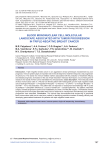
Статья научная
Introduction. Triple negative breast cancer is an aggressive clinical phenotype characterized by poor prognosis. Immune system plays an important role in the development, treatment response, and progression of solid tumor. The search for immune-related markers associated with the prediction of treatment efficacy and disease prognosis, and based on the use of high-resolution molecular techniques, is a promising area of research, the results of which can be translated into clinical practice. Case description. The molecular profile of blood mononuclear cells in a 48-year-old female patient with histologically proven triple negative breast cancer (Estrogen Receptor - 0; Progesteron Receptor - 0; Her2/neu - 0; GATA-3 - 0, Androgen Receptor - 0 and Ki67 - 70 %) was described. The patient did not response to neoadjuvant chemotherapy with 4 cycles of paclitaxel + carboplatin followed by 2 cycles of adriamycin + cyclophosphamide. The patient underwent surgery. Disease progression (pelvic bone metastases) occurred 2 months after surgery. The features of blood lymphocytes and monocytes associated with a lack of response to neoadjuvant chemotherapy and disease progression were described.
Бесплатно
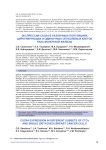
CXCR4 expression in different subsets of CTCS and single (detached) breast cancer cells
Статья научная
The aim of this study was to assess CxCR4 expression in different subsets of CTCs and single (detached) breast cancer cells. materials and methods. Thirty five patients with invasive breast carcinoma of no special type (IC NST) (T1-4N0-2M0), between 29 and 69 years of age were included in this study. Different subsets of CTCs with CxCR4 expression were evaluated by flow cytometry. A confocal microscopy was used to assess CxCR4 expression in different subsets of single (detached) cancer cells in breast tissue. results. The CxCR4 was expressed in CTCs without stem-like and EMT phenotype, in CTCs with EMT but not stem markers and in stem-like CTCs without EMT features. In all blood samples, the CxCR4 expression in CTCs with stem-like and EMT phenotype was absent. In breast tumor the CxCR4 was expressed in the non stem-like single (detached) breast cancer cells with EMT features, in the single (detached) breast cancer cells with stem and EMT features. In all tumor samples the stem-like or non stem-like single (detached) breast cancer cells without EMT features were absent. Conclusions. Different subsets of the CTCs exhibited CxCR4. The CxCR4 expression did not depend on the presence or absence of stem or/and EMT features in tumor cells. We showed that some subsets of single (detached) breast cancer cells in the primary tumor were characterized by the ability to express CxCR4 and may be a source of the respective CTC subsets.
Бесплатно

